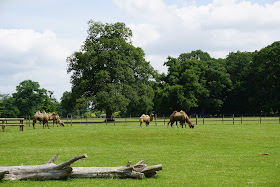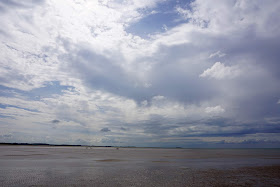Thursday, October 11, 2018
Monday, September 3, 2018
Day Trips from Cambridge
Having spent just three weeks in Cambridge this summer, we barely scratched the surface of all the places worth visiting for a day out. Here's the list of our Cambridge days out this summer. Each one was well worth the visit and a winner in my book.
Ely
Ely is a cathedral city in Cambridgeshire, about 14 miles north-northeast of Cambridge. Ely is steeped in history and is best known for Ely Cathedral, a magnificent building with its unique Octagon Tower which can be seen in the flat landscape for miles around.
Until the 17th century, Ely was an island surrounded by a large area of fenland, a type of swamp. Ely's name is derives from the time when the island city's main trade was in eels.
Queen Elizabeth I was interested in draining the fens to create more land for agriculture, but it was left to the Duke of Bedford in the 17th century to take matters in hand. In 1626 the Duke gathered support from a group of investors and called in Dutch engineer Cornelius Varmuyden to drain Hatfield Chase. Vermuyden devised a series of ditches and dykes that bit by bit reclaimed the rich peat soil form beneath the swamp waters.The Great Fen reclamation drained over 40,000 acres of land. Today it is some of the most fertile farmland in England.
There has been a church on this site since the 7th century. The monastic church became a cathedral in 1109 with the Diocese of Ely being carved out of the Diocese of Lincoln. As with most monasteries, Ely was dissolved by Henry VIII in 1539. Ely suffered less than many other though, but even so, statues were destroyed together with carvings and stained glass.
Ely's waterfront is on the banks of the Great Ouse River. It's a popular river for canal "narrow" boats and for fishing.
Oliver Cromwell’s house is the only remaining house used by Cromwell with the exception of Hampton Court Palace in London. Cromwell lived with his family in Ely for just over ten years. It is now the city's tourist information center and a museum about 17th century life.
_________________________________________________________________________________
Grantchester Meadows
Two miles south of Cambridge is a beautiful stretch of the Cam river flanked with meadows on both sides that surround the small and charming village of Grantchester. It's an easy and delightful bike ride or walk from Cambridge.
| But Grantchester! ah, Grantchester! | 100 |
| There’s peace and holy quiet there, | |
| Great clouds along pacific skies, | |
| And men and women with straight eyes, | |
| Lithe children lovelier than a dream, | |
| A bosky wood, a slumbrous stream, | 105 |
| And little kindly winds that creep | |
Round twilight corners, half asleep.
|
Along meadow banks are several swimming holes where one can swim "wild" as they say here in England. Beware that it can be muddy and crowded on a hot day! At the end of the trail is the wonderful Orchard Tea Garden, established in 1897.
Grantchester church
_________________________________________________________________________________
Houghton Mill
Houghton Mill is a restored 17th-century water mill on an island in the River Ouse. Though built in the 17th century, it was enlarged and remodelled in the 19th century. During the Victorian era, Houghton Mill was a hive of activity. The mill ran ten separate pairs of grinding stones, with the power supplied by three wheels. The wheels were removed in the 1930s, but one was restored in 1999, and this now powers a single set of stones. It is now a National Trust property.
There are several wonderful walks you can take along the banks of the Ouse that all start at Houghton Mill. It is beautiful fens land and great bird watching.
_________________________________________________________________________________
Anglesey Abbey
Anglesey Abbey is believed to have been founded by Henry 1 in 1135 as the hospital of St.Mary. In the early 13th Century it was converted into a priory of Augustinian canons (it was never strictly speaking an Abbey).
The Abbey came to an abrupt end in 1536 when Henry VIII dissolved all monasteries. In 1596 the abandoned and crumbling Anglesey was acquired by the Fowkes family, who were responsible for converting the remains of the monastic living quarters into a house in 1609.
Lord Fairhaven bought Anglesey Abbey with his brother, Henry, in 1926 and gifted it to the National Trust upon his death in 1966. During that time he filled the home with his collection of beautiful and interesting objects from all around the world. The home has been left as it was when he last lived there, in 1966. It's a fascinating slice of history.
As with most lovely English estates and National Trust properties, Anglesey Abbey has lovely grounds, beautiful gardens and lots of walking trails. Unfortunately it was raining while we were there so we didn't see as much of the grounds as we would have liked.
_________________________________________________________________________________
Oxburgh Hall
Oxburgh Hall is a moated country house in Oxborough, Norfolk, England, today in the hands of the National Trust. Built around 1482 by Sir Edmund Bedingfeld, Oxburgh has always been a family home, not a fortress. Even though it is owned by the National Trust, it is still a family home today.
Click here for an interesting timeline of the History of Oxburgh Hall. It's history starts in 1086 and it's name means 'a fortified place where oxen are kept'.
This is a priest hold -- a concealed spot created especially for priests, so they could hide away safely during a time when Catholics were persecuted. Under Queen Elizabeth I, priests were often imprisoned, tortured and even killed. Priest holes were specially disguised within a house to baffle search parties. This one was behind the big fireplace in the great hall.
_________________________________________________________________________________
Wells-next-the-Sea and Holkham
Wells-next-to-see and Holkham are lovely sea-side villages known for their long, expansive beach and, in Wells,painted beach cottage that cost a small fortune. What surprised us about the northern Norfolk coastline is how far out the water was, especially at low tide. Everywhere we stopped we had to walk a long way to get to the sea.
Had we had more time, we would have loved to see the Blakeney National Nature Reserve and the seal colony from a boat of Morton Quay. We didn't plan ahead and didn't know you have to make reservations days in advance, at least during peak vacation time. We now have a good reason to come back.
On this Sunday evening in Wells-next-to-sea there was a special service to bless the efforts of the Lifeboats and crew. Apparently the tide comes in quickly and often people are caught on a piece of beach that is quickly being engulfed by the rising tide. A fleet of lifeboats and crew are always on hand to bring stranded people safely to dry ground.
_________________________________________________________________________________
Felbrigg Hall Garden and Estate
Felbrigg Hall is a 17th-century English country house that was bequeathed the house and grounds to The National Trust in 1969. It's a beautiful home. The last owner of the housewas Robert Wyndham Ketton-Cremer. His heir, his brother Richard, was killed in action in the Second World War. Robert's memorial to Richard is in the woods behind the house.
The walled garden at Felbrigg is a complete delight with loads of flowers, vegetable beds, and exotic plants, plus a lovely dovecote.
_________________________________________________________________________________


































































